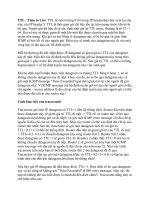HandBooks Professional Java-C-Scrip-SQL part 210 pps
Bạn đang xem bản rút gọn của tài liệu. Xem và tải ngay bản đầy đủ của tài liệu tại đây (18.5 KB, 6 trang )
mutex
A data structure for mutual exclusion, also known as a binary semaphore. A
mutex is basically a multitasking -aware binary flag that can be used to
protect critical sections from interruption.
mutual exclusion
A guarantee of exclusive access to a shared resource. In embedded systems,
the shared resource is typically a block of memory, a global variable, or a set
of registers. Mutual exclusion can be achieved with the use of a semaphore
or mutex.
N
NVRAM
Nonvolatile Random-Access Memory. A type of RAM that retains its data
even when the system is powered down. NVRAM frequently consists of an
SRAM and a long-life battery.
O
OTP
See one-time programmable.
object code
A set of processor-readable opcodes and data. The output of compilers,
assemblers, linkers, and locators are files containing object code.
object file
A file containing object code. The output of a compiler or assembler.
one-time programmable
Any programmable device, like a PROM, that can be programmed just once
by the end user. However, this term is used almost exclusively to refer to
microcontrollers that have on-chip PROM.
opcode
A sequence of bits that is recognized by the processor as one of the
instructions in its instruction set.
operating system
A piece of software that makes multitasking possible. An operating system
typically consists of a set of function calls, or software interrupts, and a
periodic clock tick. The operating system is responsible for deciding which
task should be using the processor at a given time and for controlling access
to shared resources.
oscilloscope
A hardware debugging tool that allows you to view the voltage on one or
more electrical lines. For example, you might use an oscilloscope to
determine if a particular interrupt is currently asserted.
P
PROM
Programmable Read-Only Memory. A type of ROM that can be written
(programmed) with a device programmer. These memory devices can be
programmed only once, so they are sometimes referred to as write-once or
one-time programmable devices.
parallel processing
The ability to apply two or more processors to a single computation.
peripheral
A piece of hardware other than the processor, usually memory or an I/O
device. The peripheral can reside within the same chip as the processor, in
which case it is called an internal peripheral.
physical address
The actual address that is placed on the address bus when accessing a
memory location or register.
preemptive
A scheduler is said to be preemptive if it allows the running task to be
suspended when a higher-priority task becomes ready. Non-preemptive
schedulers are easier to implement but less appropriate for embedded
systems.
priority
The relative importance of one task compared to another.
priority inversion
An unwanted software situation in which a high-priority task is delayed
while waiting for access to a shared resource that is not even being used at
the time. For all practical purposes, the priority of this task has been lowered
during the delay period.
process
A word that is often confused with task or thread. The crucial distinction is
that all of the tasks in a system share a common memory space. Processes,
on the other hand, always have their own private memory space. Processes
are common in multi-user systems but are rarely, if ever, found in embedded
systems.
processor
A generic term that does not distinguish between microprocessor,
microcontroller, and digital signal processor. I have purposefully used this
term throughout the book because the actual processor type has very little
impact on the type of embedded software development described here.
processor family
A set of related processors, usually successive generations from the same
manufacturer. For example, Intel's 80x86 family began with the 8086 and
now includes the 80186, 286, 386, 486, Pentium, and many others. The later
models in a family are typically backwards-compatible with the ones that
came before.
processor-independent
A piece of software that is independent of the processor on which it will be
run. Most programs that can be written in a high-level language are
processor-independent. Contrast with processor-specific.
processor-specific
A piece of software that is highly dependent on the processor on which it
will be run. Such code must usually be written in assembly language.
Contrast with processor-independent.
profiler
A software development tool that collects and reports execution statistics for
your programs. These statistics include the number of calls to each
subroutine and the total amount of time spent within each. This data can be
used to learn which subroutines are the most critical and, therefore, demand
the greatest code efficiency.
program counter
See instruction pointer.
R
RAM
Random-Access Memory. A broad classification of memory devices that
includes all devices in which individual memory locations can be read or
written as required.
RISC
Reduced Instruction Set Computer. Describes the architecture of a processor
family. RISC processors generally feature fixed-length instructions, a load-
store memory architecture, and a large number of general-purpose registers
or register windows. The MIPS processor family is an excellent example.
Contrast with CISC.
ROM
Read-Only Memory. A broad classification of memory devices that includes
all devices in which the individual memory locations can be read but not
written.
ROM emulator
A debugging tool that takes the place of—or emulates—the ROM on your
target board. A ROM emulator acts very much like a debug monitor, except
that it includes its own serial or network connection to the host.
ROM monitor
See debug monitor.
RTOS
Real-Time Operating System. An operating system designed specifically for
use in real-time systems.
race condition
A situation in which the outcome of a program can be affected by the exact
order in which the instructions are executed. Race conditions are only an
issue where interrupts and/or preemption are possible and where critical
sections exist.
real-time system
Any computer system, embedded or otherwise, that has deadlines. The
following question can be used to identify real-time systems: is a late answer
as bad as, or even worse than, a wrong answer? In other words, what
happens if the computation doesn't finish in time? If nothing bad happens,
it's not a real-time system. If someone dies or the mission fails, it's generally
considered "hard" real-time, which is meant to imply that the system has
"hard" deadlines. Everything in between is "soft" real-time.









